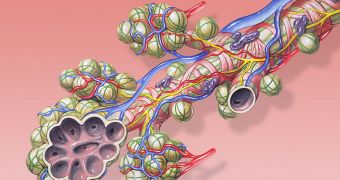The human lungs can grow back slowly, after being surgically removed, investigators showed in a new study. The effect is not immediate, the team says, as their study spanned a period of around 15 years.
Nevertheless, the work represents a groundbreaking discovery, considering that scientists used to believe such a feat was impossible. The researchers focused their attention on a woman who had her entire right lung surgically removed due to cancer, more than 15 years ago.
Now, after all this time, the number of alveoli in her right lung has increased by 64 percent, a figure that cannot be explained by natural variation. An alveoli is a tiny unit inside the lung responsible for exchanging carbon dioxide and oxygen between the blood and environment.
These units are made up of cells that have extremely thin walls. When we inhale, oxygen passes from the air into these cells, and then binds to hemoglobin, which carries it through the bloodstream all the way to every cell in the body.
When we exhale, carbon dioxide from the blood stream passes through the cellular membranes into the alveoli, from where it is expelled into the environment. The fact that these units can regenerate is great news to doctors and patients alike, and even smokers.
In the future, it may become possible to amplify this natural tendency to heal the human body displays, therefore making it easier for it to regenerate. However, such applications are still a long way off.
The work was led by Harvard Medical School (HMS) Department of Medicine associate professor of medicine, James Butler. He is also the author of the new research paper detailing the findings, HealthDay News reports.
The scientist explains that he and his team used Magnetic Resonance Imaging (MRI) to investigate what was going on in the patient's lungs. Hyperpolarized helium-3 gas was used as to evidence the regenerative growth.
“The research clearly shows that some form of lung growth can occur in the adult human. If we can discover the underlying bio-molecular mechanisms, they would suggest potential therapeutic options,” Butler concludes.

 14 DAY TRIAL //
14 DAY TRIAL //